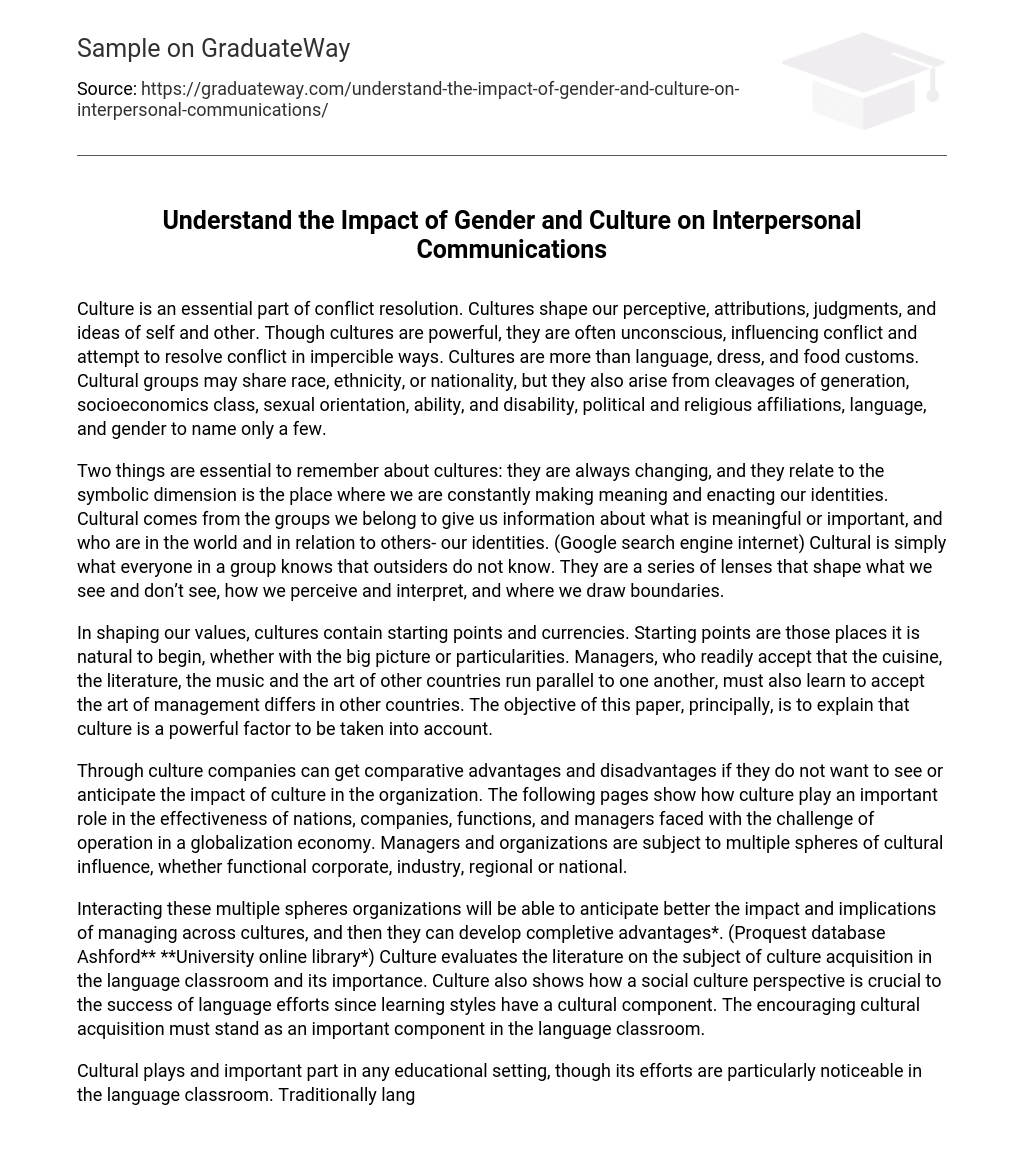Culture is an essential part of conflict resolution. Cultures shape our perceptive, attributions, judgments, and ideas of self and other. Though cultures are powerful, they are often unconscious, influencing conflict and attempt to resolve conflict in impercible ways. Cultures are more than language, dress, and food customs. Cultural groups may share race, ethnicity, or nationality, but they also arise from cleavages of generation, socioeconomics class, sexual orientation, ability, and disability, political and religious affiliations, language, and gender to name only a few.
Two things are essential to remember about cultures: they are always changing, and they relate to the symbolic dimension is the place where we are constantly making meaning and enacting our identities. Cultural comes from the groups we belong to give us information about what is meaningful or important, and who are in the world and in relation to others- our identities. (Google search engine internet) Cultural is simply what everyone in a group knows that outsiders do not know. They are a series of lenses that shape what we see and don’t see, how we perceive and interpret, and where we draw boundaries.
In shaping our values, cultures contain starting points and currencies. Starting points are those places it is natural to begin, whether with the big picture or particularities. Managers, who readily accept that the cuisine, the literature, the music and the art of other countries run parallel to one another, must also learn to accept the art of management differs in other countries. The objective of this paper, principally, is to explain that culture is a powerful factor to be taken into account.
Through culture companies can get comparative advantages and disadvantages if they do not want to see or anticipate the impact of culture in the organization. The following pages show how culture play an important role in the effectiveness of nations, companies, functions, and managers faced with the challenge of operation in a globalization economy. Managers and organizations are subject to multiple spheres of cultural influence, whether functional corporate, industry, regional or national.
Interacting these multiple spheres organizations will be able to anticipate better the impact and implications of managing across cultures, and then they can develop completive advantages*. (Proquest database Ashford** **University online library*) Culture evaluates the literature on the subject of culture acquisition in the language classroom and its importance. Culture also shows how a social culture perspective is crucial to the success of language efforts since learning styles have a cultural component. The encouraging cultural acquisition must stand as an important component in the language classroom.
Cultural plays and important part in any educational setting, though its efforts are particularly noticeable in the language classroom. Traditionally language acquisition is simply considered to be a matter of memorizing vocabulary and learning new grammatical structures. But language is much more complex than this, and true proficiency in a language requires a more sophisticated understanding of the language being taught. Culture is a learned system of beliefs that are personalized and that affect every aspect a student’s life.
Culture is expressed through language which is often particular to societal group and requires a complete understanding of cultural values to comprehend. Culture impacts every child that enters the school system because culture impacts how the child thinks, learns and becomes socialized in the educational community. Because the influences of culture on children begin from the time of birth, the information that affects the child’s development is significant and so is the potential for conflict to arise within the classroom.
This is because the student has learned to value his or her cultural ideas, which often become completely separate from the social norms expected in school. Therefore, how culture is embraced or denied in the classroom has the potential to have long term affects on the manner in which the student continues a relationship with learning about their culture and culture around the world. Teachers must instruct their students on the cultural backgrounds of language usage.
If one teaches language without teaching about the culture in which it operates, the students are learning empty or meaningless symbols or they may attach the incorrect meaning to what is being taught. The students when using the learnt language may use the language inappropriately or within the wrong cultural context, thus defeating the purpose of learning a language. Conflict in teaching styles also stem from the relationship between language and culture. Because language is so closely entwined with culture, language teachers entering a difficult must respect their cultural values.
As Englebert (2004) describes” to teach a foreign language is also to teach a foreign culture, and it is important to be sensitive to the fact that students, our colleges, our administration and, if we live abroad, our neighbors, do not share all of our cultural paradigms. In conclusion, culture is a part of all our well being. In every part of the world culture is taught in a different way. Language is also a part of the way culture is being taught to us. References 1. Google search engine under culture 2. Proquest online library





